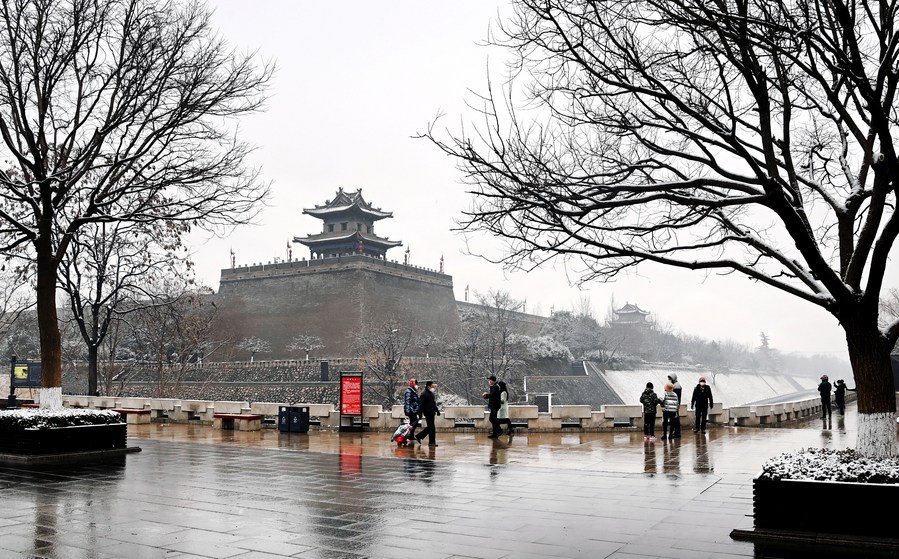Cosmic ray particles shed light on ancient relics protection

Citizens visit the ancient city wall in Xi'an, northwest China's Shaanxi Province, Jan. 23, 2022. (Xinhua/Tao Ming)
LANZHOU, Jan. 18 (Xinhua) -- Mysterious cosmic ray particles are shedding light on the protection of relics as Chinese researchers apply muons to check the health of the renowned Xi'an ancient city wall in northwest China's Shaanxi Province.
Researchers from Lanzhou University in northwest China's Gansu Province have collaborated with the relics protection authorities of Xi'an, capital of Shaanxi, to apply high-energy cosmic ray particles to probe through the city wall.
"The in-depth imaging of large-scale relics has challenged the ancient relics conservators and scientists. Our solution is cosmic ray muons from space," said Liu Zhiyi, a professor with the Frontiers Science Center for Rare Isotopes of Lanzhou University and leader of the study team.
The researchers have recently developed the non-destructive imaging of cosmic ray muons to get images of the interior of large-sized structures from a distance. They recently applied the technique in relics preservation in Xi'an.

Aerial photo taken on Jan. 1, 2021 shows people visiting the ancient city wall at sunset in Xi'an, northwest China's Shaanxi Province. (Xinhua/Tao Ming)
Xi'an boasts one of China's most well-preserved ancient city walls. It is of great value in studying ancient Chinese society's urban construction, history, culture, military defense, and architecture.
Experiencing hundreds of years, some parts of the wall sunk or collapsed. Some of the lesions are embedded deep in the wall, posing more challenges for archaeological conservators in relics detection and restoration.
Therefore, it is the key task of conservators and scientists to join efforts in understanding the inner structure of the ancient wall and then carrying out targeted restoration.
As one of the fundamental particles in nature, muons have a significant penetration capability, which can realize non-contact, deep penetrating, and non-destructive imaging of large objects. Compared with conventional artificial ray devices, they have incomparable advantages, said Liu.
Based on the muons imaging technology, the study team developed a set of high-precision equipment to carry out safe internal detection of large-scale cultural relics and historic sites.
In collaboration with the Xi'an city wall management committee, the researchers selected one section of the ancient city wall to apply the technique and related devices. They used muon sensors to create a three-dimensional density image. They paired that with a method to remove noise from the images and evaluate the uncertainty.
In the tested city-wall section, the researchers successfully detected the density-abnormal parts and marked their position, shape, and size clearly.
The results demonstrated the feasibility of using the technique to survey large-scale archeological sites at a high enough resolution to support relics preservation works.
Now, the research team is improving their sensors and data analysis software to aid other archaeological sites around China, according to Liu.
Worldwide, there are a massive number of historical and valuable cultural relics. Chinese researchers propose the global relics protection circle as a new solution inspired by cosmic particles.
"The new technique offers an environmental-friendly and high-resolution option to increase their cultural-relic knowledge and carry out effective conservation," said Liu, adding that the new technique also has prospects in glacier expeditions, landslide monitoring, and multiple other fields.
Photos
Related Stories
Copyright © 2023 People's Daily Online. All Rights Reserved.









